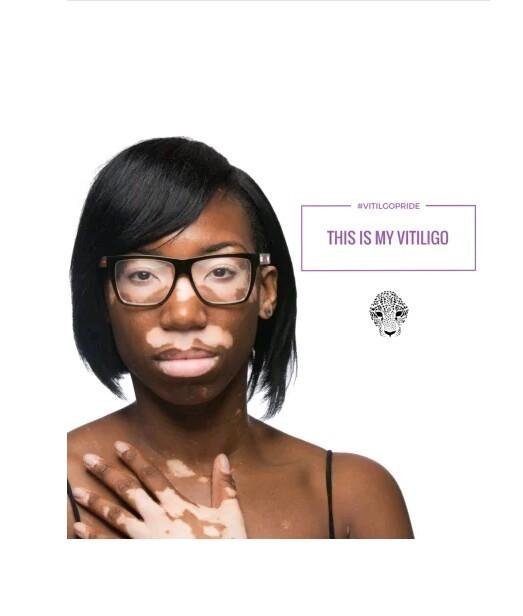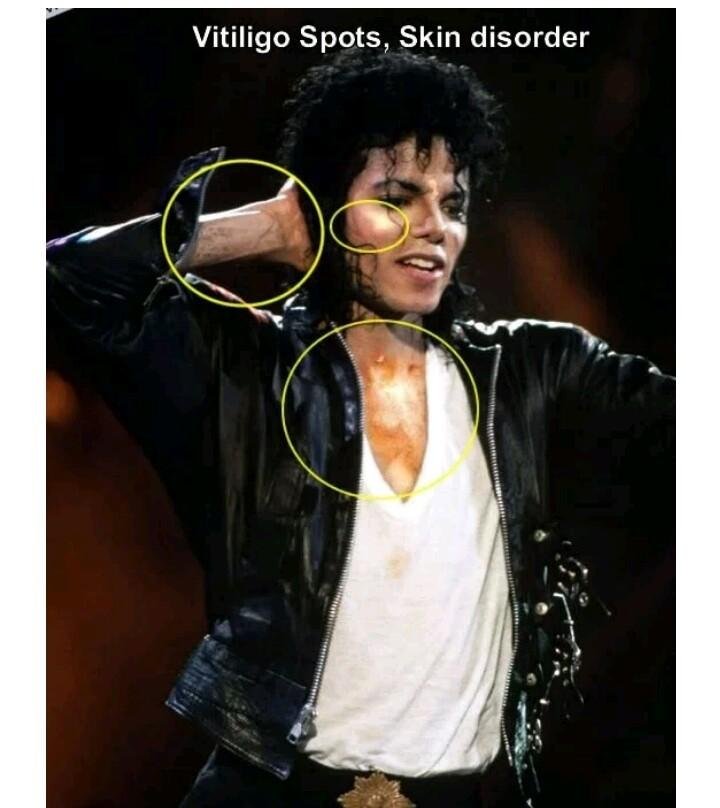BRIEF DESCRIPTION
Vitiligo is a long-term skin condition characterized by patches of the skin losing their pigment. The patches of skin affected become white and usually have sharp margins. The hair from the skin may also become white. Inside the mouth and nose may also be involved. Typically both sides of the body are affected. Often the patches begin on areas of skin that are exposed to the sun. It is more noticeable in people with dark skin.

SYMPTOMS OF VITILIGO

The main sign o HVf vitiligo are white patches on the skin. These patches are more common in areas where the skin is exposed to the sun. The patches may be on the hands, feet ,arms, face, and lips. Other common areas for white patches are:
The armpits and groin (where the leg meets the body)
Around the mouth
Eyes
Nostrils
Navel
Genitals
Rectal areas.
People with vitiligo often have hair that turns gray early. Those with dark skin may notice a loss of color in their mouth.
WHO IS AFFECTED?
This disorder affects all races and sexes equally. Vitiligo can occur at any age, but it's most likely to occur when in your twenties. People with certain autoimmune diseases such as hyperthyroidism are more likely to get vitiligo than those without any autoimmune disease.
Vitiligo could also be hereditary, it most likely kids whose parents has it, could get it, but some kids don't have it even if their parent do.
CAUSES
Although multiple hypotheses have been suggested as potential triggers that cause vitiligo, studies strongly imply that changes in the immune system are responsible for the condition.
Vitiligo has been proposed to be a multifactorial disease with genetic susceptibility and environmental factors both thought to play a role.
The TYR gene encodes the protein tyrosinase , which is not a component of the immune system, but is an enzyme of the melanocyte that catalyzes melanin biosynthesis, and a major autoantigen in generalized vitiligo.
The NIH states that sunburns can cause the disease but there is not good evidence to support this.
Preliminary evidence suggests a possible association with eating gluten
Variations in genes that are part of the immune system or part of melanocytes have both been associated with vitiligo.
It is also thought to be caused by the immune system attacking and destroying the melanocytes of the skin.
Vitiligo is sometimes associated with
autoimmune and inflammatory diseases such as Hashimoto's thyroiditis, scleroderma ,
rheumatoid arthritis , type 1 diabetes mellitus ,
psoriasis , Addison's disease , pernicious anemia , alopecia areata , systemic lupus erythematosus , and celiac disease .
PSYCHOLOGICAL EFFECTS
Vitiligo is an important skin disease having major impact on quality of life of patients, many of whom feel distressed and stigmatized by their condition. Society greets vitiligo patients in much the same way as it does any one else who appears to be different. They are stared at or subjected to whispered comments, antagonism, insult or isolation. The chronic nature of disease, long term treatment, lack of uniform effective therapy and unpredictable course of disease is usually very demoralizing for patients suffering from vitiligo. It is important to recognize and deal with psychological components of this disease to improve their quality of life and to obtain a better treatment response.
Vitiligo has a major psychological impact on the quality of life of patients suffering from it.
Appearance of skin can condition an individual self-image, and any pathological alteration can have psychological consequences .Many vitiligo patients feel distressed and stigmatized by their condition. They attract undue attention from the general public some times whispered comments, antagonism and ostrisisam. The self image of the vitiligo patients drops considerably and may lead to depression. These patients often develop negative feeling about it, which are reinforced by their experiences over a number of years. Most patients of vitiligo report feelings of embarrassment, which can lead to a low self-esteem and social isolation .Vitiligo lesions over face may be particularly embarrassing and the frustration of resistant lesions over exposed part of hands and feet can lead to anger and disillusionment. Particularly in teenagers, mood disturbances including irritability and depression are common. Patients with vitiligo are very sensitive to the way other perceives them and they will often withdraw, because they anticipate being rejected. Sometimes, strangers and even close friends can make extremely hurtful and humiliating comments. The impact of such factors is profound subjecting them to emotional distress, interference with their employment, or use tension-lessoning, oblivion-producing substances such as alcohol . Severe depression has been known to lead to suicide attempts.
Patients with vitiligo often suffer financial loss because they often have to take time off work to attend hospital appointments like PUVA appointment. Vitiligo lesions over exposed sites can adversely affect a person's chances of getting a job at interview and so restrict career choices. Vitiligo beginning in childhood can be associated with significant psychological trauma that may have long lasting effects on the personal self-esteem of these children. Children with vitiligo usually avoid sport or restrict such activities.
- Children often lose vital days from school. Parents of children with vitiligo may have to take time off their work to regularly accompany them for hospital appointments.
Children with vitiligo deal with the disease well or be devastated by it, often depending on the attitude of their parents, siblings, relatives, teachers, friends, baby sitters etc.
Vitiligo can also result in problems in interpersonal relations particularly as a result of depression and frustration. Patients often feel that their family members are not supportive or lack understanding.
The chronic nature of disease, long term treatment, lack of uniform effective therapy and unpredictable course of disease is usually very demoralizing for patients suffering from vitiligo.
According to report, majority of vitiligo patients experienced anxiety and embarrassment when meeting strangers or beginning a new sexual relationship and many felt that they had been the victims of rude remarks.
NOTABLE CASES

Pop music singer Michael Jackson revealed in an interview with Oprah Winfrey in February 1993 that he had vitiligo. Following his death in 2009 , Jackson's autopsy confirmed his claim, and clarified that he specifically had vitiligo universalis.

Canadian model Chantelle Brown-Young (known by her stage name Winnie Harlow) has a prominent form of vitiligo. She was teased, made fun of, which led her changing schools, she even attempted suicide. Her participation in the America's Next Top Model contest led to her being called a "vitiligo spokesmodel". She defied all odds, and refused to allow her vitiligo beauty be covered by any form of make up.
P. Sathasivam , who is the current Governor of Kerala, in office since 2014, has vitiligo. He previously served as the 40th Chief Justice of India from 2013 to 2014.
Former WBC Interim Middleweight Boxing Champion Marco Antonio Rubio has vitiligo.
NCAA assistant coach Karl Dunbar was diagnosedCurtis McDaniel a vitiligo model redefined what it means to be beautiful. According to an interview with CNN, he said "This is who I am. This was part of my purpose," he said. "I wouldn't be where I am now if it wasn't for my vitiligo."
MYTHS AND FACTS ABOUT VITILIGO
The common facts and myths about vitiligo are:
MYTH: All white patches are vitiligo
FACT: All white patches are not vitiligo. The white patches on the skin may appear due to:
Fungal infections
Chemical leukoderma
Congenital leukoderma
Leprosy
Post inflammatory Hypopigmentation
MYTH: Vitiligo is contagious
FACT: This is the common myth about vitiligo. It is not contagious and cannot spread from touching, saliva, inhalation, blood, sexual intercourse or sharing of personal items (drinking bottle, towels).
Myth: Eating wrong food items can cause vitiligo
FACT: There is no scientific study that supports this belief. Many believe that Vitiligo can be caused by drinking milk shortly drinking after eating fish, sour foods like citrus fruits. Infact, many studies have shown that antioxidants such as folic acid, ascorbic acid, lipoic acid and vitamin B12 increase the effectiveness of phototherapy to cure vitiligo.
MYTH: Vitiligo cannot be cured
FACT: Vitiligo can be cured. However, its treatment is difficult but around 70 per cent people show good response to its treatment.
MYTH: Vitiligo is dangerous
FACT: This is a cosmetic problem and not dangerous at all. It may affect a person's emotional affected person's self worth.
MYTH: It is related to Albinoism
FACT: Albinos are born with melanin cells that do not produce pigment. Patients with vitiligo once had functioning melanin cells, but no longer work.
TREATMENT
Treatment may help make the skin look more even.
The choice of treatment depends on:
- The number of white patches
- How widespread the patches are
- The treatment the person prefers to use.
Some treatments are not right for everyone. Many treatments can have unwanted side effects. Treatments can take a long time, and sometimes they don't work.
Current treatment options for vitiligo include medical, surgical, and other treatments.
Most treatments are aimed at restoring color to the white patches of skin.
- Medical treatments include:
Medicines (such as creams) that you put on the skin
Medicines that you take by mouth
A treatment that uses medicine plus ultraviolet A (UVA) light ( PUVA )
Removing the color from other areas so they match the white patches.
- Surgical treatments include:
Skin grafts from a person's own tissues. The doctor takes skin from one area of a patient's body and attaches it to another area. This is sometimes used for people with small patches of vitiligo
Tattooing small areas of skin.
- Other treatments include:
Sunscreens
Cosmetics ,such as makeup or dye, to cover the white patches
Counseling and support
Vitiligo has a profound effect on the quality of life of vitiligo patients, and so the patients go to any extent in getting it treated although it is not life threatening. The dermatologists should treat it as serious disease with the various treatment modes now available and not dismiss simply because of not having a completely successful treatment.People with vitiligo should be given all the love and support necessary, and not segregated. They are just like every human being out there, and should be treated as one.
References
Wikipedia
skinguide.com
https://www.ncbi.nlm.nih.gov/pmc/articles/PMC269995/
Thanks for reading ☺